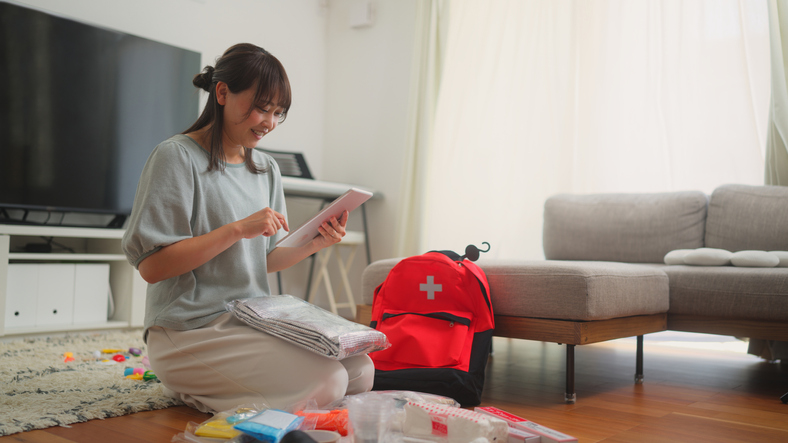Commitment + Clinical Leadership = Better Outcomes

What should you pack in a first aid kit?
You should always have a first aid kit in your home, car, or whenever you travel. A first aid kit can be the first step to stopping infection and caring for minor injuries.
Here is a list of items that you should pack in your first aid kit:
- Band-aids. You should pack band-aids of all sizes to cover the most common sizes of cuts.
- Antibacterial wipes. This is the first step to stopping infection. Pack antibacterial wipes in your first aid kit, and be sure to replace them as they expire.
- Antiseptic spray. This will be used to spray on wounds and help clean them up.
- Hand sanitizer. It is important to use hand sanitizer before treating a wound because the bacteria on your hands could cause an infection.
- Cold pack. There are instant cold packs you can put into a first aid kit that will become cold once you use them.
- Scissors. Scissors are important for opening packaging, cutting gauze, and opening medications.
- Thermometer. It is important to have a thermometer to check someone’s temperature in an emergency.
- Tweezers. If the skin is pierced by a splinter or bee stinger, tweezers can be an invaluable tool for removing these.
- Gauze rolls: Gauze is important to help cover up injuries that are bigger than a small cut.
- Gauze pads: Gauze pads can be put over larger cuts and wounds to help absorb some of the bleeding.
- Medical tape: This is used to help secure gauze that is wrapped around the skin.
- Gloves: Gloves are important to help treat someone who has an open wound. You should consider getting non-latex gloves in case someone has an allergy.
- Cotton balls. You might need cotton balls to use with antiseptic liquid to help sanitize a cut or wound before applying a bandage.
- Soap. Soap can be used to help wash away blood from a cut or scrape.
- Flashlight and batteries. Some wounds may require a good look to check how to deal with the case. A flashlight and batteries can allow you to better examine any situation you might come across.
- A CPR mouthpiece. It is important to have a mouthpiece that is designed for when you administer CPR to someone. This will eliminate the risks of mouth-to-mouth contact.
- Eyewash solution. If something gets into the eye, eyewash solution can be a way to help cleanse the eye.
- Eye shield. An eye shield should be used on an eye that needs to be protected from dust and outside pathogens.
Medications
- Pain relievers. Aspirin or ibuprofen can be valuable in helping someone recover from pain or cramps. If you have kids, talk to a doctor about the best pain relivers for them as well as dosage instructions.
- Calamine lotion: This is a special type of lotion to help people with bee stings, poison ivy, and other conditions such as bites.
- Cough and cold medications. If someone comes down with a cough, cough medications should be kept on hand. You should also consider keeping some cough drops.
- Hydrocortisone cream. This cream helps relieve itchiness, redness, or discomfort from rashes, swelling, and other similar skin conditions.
- Laxatives and anti-diarrhea medication. These are essential medications should someone in your family experience any digestive problems.
- Personal medications. If you or someone in your family has a health condition, then medications should be stocked in your first aid kit.
- Other medical condition items. If someone in your family has a medical condition, such as diabetes, you should put a juice box and other medications to help them in case of an emergency.
- Pain relievers. Pain relivers can be used to reduce headaches, relieve sore muscles, and ease arthritis symptoms.
Other items:
- Emergency phone number: Write down any emergency phone numbers that your family might need in case of an emergency.
- Emergency blanket. Blankets are necessary for some health conditions or in case of sudden temperature changes.
- Emergency instructions. You should have an easy-to-follow instruction manual for any common health conditions that people in your family might experience.
Restocking a First Aid kit
You should always periodically check your first aid kit is up-to-date. Check every 6 months to ensure that items haven’t expired or that certain items don’t need to be replaced after use. If some of the items go bad, remove them and replace them with items that aren’t expired.
Saber Healthcare
Saber Healthcare is an organization that provides services to more than 130 buildings across the states of Ohio, Pennsylvania, Virginia, North Carolina, Indiana, and Delaware. To learn more about our company and services, click here.
Saber Healthcare is an organization dedicated to providing consultant services to long-term care providers. This article is for informational purposes and is not meant to be seen as professional advice. Please consult with a medical expert before relying on the information provided.
